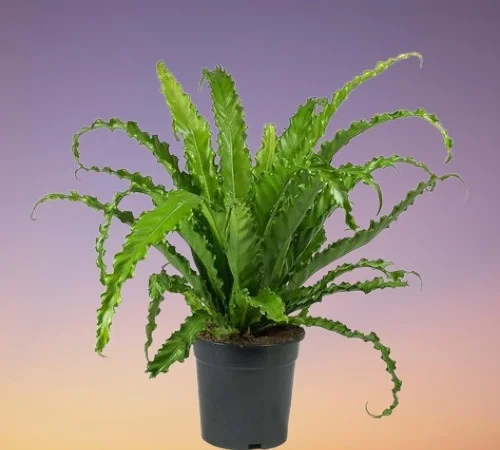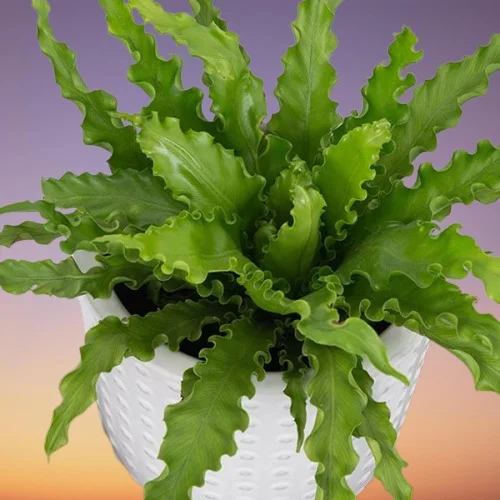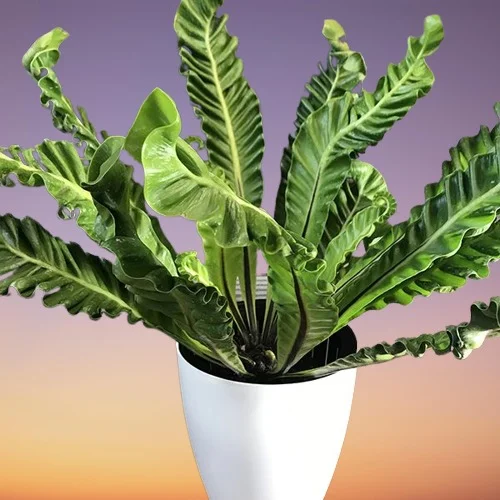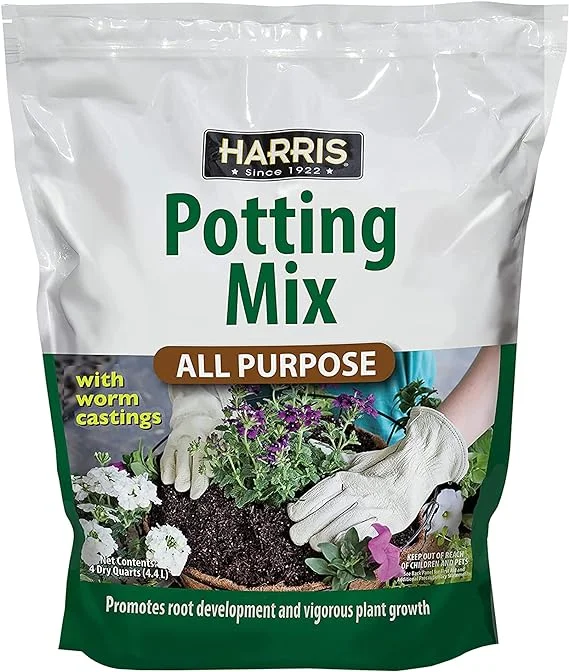Asplenium nidus (Bird's Nest Fern) Indoor Care, Common Problems and Solutions
Some links in this post may be affiliate links
Bird's Nest Fern (Asplenium nidus) thrives in bright indirect light, warm and humid conditions, and consistently moist, rich, well drained soils coupled with monthly feeding in the growing season.
Asplenium nidus also called Asplenium Fern is one of the bold statement plants and is beautiful enough to be displayed as a focal point plant in a large space.
The Asplenium Fern fronds are upto to 3 feet long. They are quite fragile, therefore, ensure that they are not crushed and that they have adequate room to develop.
Remove dead and damaged fronds so that new ones can grow. As the plant ages, the older, outer fronds turn brown. Cut them off at the base to maintain the plant looking neat.

Botanical name: Asplenium nidus
Family: Aspleniaceae
Common names: Bird's Nest Fern, Asplenium Fern
Origin
Asplenium nidus is native to the warm, moist, tropical rain forests of East africa and Asia where it grows as an epiphyte. However it adapts well to indoor growing conditions.
Due to its affinity for high moisture, Asplenium nidus is one of the best plants for a closed terrarium. The magnificient green leaves are a sight to behold inside a terrarium.
How big do Asplenium Fern grow?
The spear-like leaves on Asplenium Fern which surround the fibrous 'nest' at the center are large and can grow up to 3 feet long. When grown indoors, the Fern can grow to a height of 2 feet.
Is Asplenium nidus toxic?
No. Asplenium nidus are considered non-toxic to humans and pets as they have not been listed by ASPCA to be among the toxic plants. They are safe to grow in the home.
Varieties
Some varieties of Bird's Nest Fern include;
Asplenium nidus 'Crispy Wave' which bears sword-shaped, ruffled leaves.
Asplenium nidus 'Osaka' which bears narrow, strap-like leaves with rippled edges.
Asplenium nidus 'Antiquum' which bears leaves with wavy margins.
Asplenium nidus 'Victoria' which bears long, wavy, tongue-shaped fronds.
Where to Buy
If you are looking to add Bird's Nest Ferns to your plant collection, you may acquire them online from Amazon (Link to Amazon).
How to Care for Asplenium nidus Indoors
To care for Asplenium nidus indoors, provide bright indirect light, warmth of 15-250C, humidity of 60-70% and consistently moist, rich, well drained soils coupled with monthly feeding during the growing season.
Bird's Nest Fern requires regular pruning to keep it neat, reduce pest and disease infestations and create enough room for new growth. Young plants need to be repotted annually but the mature plants are only repotted when pot-bound. Keep reading for more on these growing conditions and how to achieve them.

Watering
How often should I water Asplenium Fern?
For optimum growth, water Asplenium Fern liberally in spring and summer while allowing the top 1-2 inches of soil to dry out between waterings. Keep soil evenly moist throught out but take care not to overwater to avoid rotting stems and yellowing leaves.
Reduce watering in fall and winter as growth is minimal at this time to maintain the soil slightly moist. Do not allow the soil to dry out completely to prevent yellowing, wilting and drooping leaves.
Use room temperature water to avoid cold shock which can result in reduced growth and leaf fall. Only use water that is free of chlorine and other dissolved chemicals to avoid browning of leaf tips and edges.
Make sure that the pot has a drainage hole and the soil is free-draining to prevent waterlogging which can lead to rotting and eventual death of the fern.
Avoid wetting the crown as it may lead to crown rot in the Bird's Nest Fern; instead pour the water on the soil or water from below.
Light Requirements
Where should I put Bird's Nest Fern?
Bird's Nest Fern grows best in bright indirect light. Put it infront of a large, well-lit window. Keep it away from direct sunlight as it may scorch the fronds.
If the lighting is too low, the fern may develop smalll, pale leaves (yellowish leaves). You may full spectrum grow lights where the natural lighting is not sufficient.
Rotate the pot regularly to ensure that the plant receives light on all sides for even growth and prevent lopsided growth.
Temperature & Humidity
Bird's Nest Fern flourishes in an average warmth between 15-250C. Keep it away from cold drafts to avoid sudden changes in temperature as they can cause wilting and curled leaf edges.
Asplenium Fern blossoms in a humidity of 60-70%. To increase humidity, group the plants together, set the pot on a wet pebble tray or use a cool mist humidifier. Maintain a good air flow to discourage fungal diseases.
You may also grow the plant in the humid areas in the home like a bathroom and the kitchen if there is adequate lighting. A closed terrarium is also ideal for growing this fern as a high humidity can be maintained inside a terrarium.
Fertilizer
Feed Asplenium Fern with a balanced, liquid fertilizer once a month in spring and summer for lush growth. Do not feed it in fall and winter as growth is reduced at this time.
Take care not to overfeed as overfeeding can lead to deformed and spotted leaves. Do not put fertilizer in the central cup or 'nest' as it can burn the delicate foliage or even cause the death of the plant.
Potting Mix
The best potting mix for Bird's Nest Fern should be rich in organic matter and free-draining to prevent it from getting soggy while providing the required nutrients. A mix of 2 parts all purpose potting mix and 1 part of perlite is ideal for this fern.
Pruning & Grooming
Pruning Bird's Nest Fern is easy. Remove dead and damaged fronds so that new ones can grow. As the Fern ages, the older, outer fronds turn brown. Cut them off at the base to maintain the fern looking neat.
Use a clean sterilized knife or pair of pruning scissors to reduce spread of diseases. Ensure to use a sharp cutting tool to avoid unnecessary injury to the plant as it can promote disease infestation.
Regularly clean the fronds by damp-wiping with a soft cloth to keep them clean and shiny as well as discourage pest infestation.
Repotting
Repot a young Asplenium Fern annually at the beginning of the growing season (spring to early summer). For mature a plant repot when the the roots fill the pot as they prefer to be slightly root-bound.
Use a pot that is 1 size larger than the current one. Confirm that the soil is well-draining and pot has drainage hole to avoid getting soggy soil as it can cause rotting.
Bird's Nest Fern can become top-heavy therefore use a heavy pot to prevent it from toppling over. Ascertain that the crown is above the soil surface to prevent the fern from rotting. Check out these ceramic pots with drainage holes and saucer on Amazon.
Asplenium nidus Propagation
Bird's Nest Fern (Asplenium nidus) is propagated from spores obtained from the underside of the mature fronds or through tissue culture.
These methods of propagating Asplenium Fern may not be achievable at the home front; in which case propagation is better left to the experts.

Asplenium nidus Problems & Remedies
Asplenium nidus (Bird's Nest Fern) problems are yellowing, stunted growth, leaf spots, die back and pests. Keep reading for more on these problems and how to fix them.
Yellowing fronds
Yellowing fronds on Asplenium nidus are caused by inconsistent watering, soggy soil or too little light.
How to fix it
Inconsistent watering: Do not water on a schedule. Water when the top 1-2 inches of soil dry out but never allow the soil to dry out completely.
Soggy soil: Ensure that the pot has a drainage hole and that the soil drains easily to prevent it from staying too wet.
Too little light: Position the plant in bright indirect light or use a grow light if the natural lighting is not enough.
Yellowing and brown spots on mature fronds
Yellowing and brown spots on mature fronds on Bird's Nest Fern is caused by hot drafts or inconsistent watering.
How to fix it
Hot drafts: Move the fern to a cooler place away from hot drafts like heat vents and hot surfaces.
Inconsistent water: Water when the top 1-2 inches of soil dry out slightly but never allow the soil to dry out completely.
Yellowing fronds, brown tips, stunted growth
The cause of yellowing fronds, brown tips and stunted growth on Asplenium nidus is too dry air resulting in low humidity.
How to fix it
Dry air: Set the pot on a wet pebble tray, use a cool mist humidifier or group the plants together to heighten humidity. You may also grow the fern in a terrarium as a high humidity can be maintained inside a terrarium.
Pale fronds and weak growth
Pale fronds and weak growth on Bird's Nest Fern are caused by underfeeding or too little light.
How to fix it
Underfeeding: Feed the fern with a balanced fertilizer once a month in spring and summer but do not feed in fall and winter as growth is reduced.
Too little light: Move the fern to a brighter spot where it will receive bright indirect light or instal a grow light if the natural lighting is not adequate.
Pale fronds and scorch marks
Pale fronds and scorch marks on Asplenium nidus are caused by exposure of the fern to hot direct sunlight.
How to fix it
Shield the fern from direct sunlight or move it to a shaded place where it will receive bright indirect light but away from direct sunlight.
Die back of fronds
Fronds die back on Bird's Nest Fern is caused by low humidity or underwatering.
How to fix it
Low humidity: To elevate the humidity, set the pot on a wet pebble tray or grow the fern in a well-lit bathroom and other moist areas in the home.
Undewatering: Water when the top 1-2 inches of soil feel dry to the touch but do not allow the soil to dry out completely.
Brown dots or lines on the underside of fronds
Brown dots or lines on the underside of your Asplenium nidus are spores which can be used for propagation. They indicate that the frond is mature and healthy.
Brown hairy fuzz on the fronds
Brown hairy fuzz on the fronds of Bird's Nest Fern is harmless. As new fronds emerge from the nest, they bring up some brown fuzz from the nest which sticks on the fronds.
You can remove the brown fuzz from the fronds by gently brushing it off. Or you can choose to leave it alone as it will eventually dry out to become dust-like.
Brown shells scattered on the fronds
Brown shells scattered on the fronds of Asplenium nidus are an indication of a infestation by scale insects. Isolate the affected fern to prevent spread to the other plants and treat it appropriately for the pests.
Wipe them off with a damp soft cloth or a cotton bud dabbed or discard the fern if it is heavily infested. Avoid chemical use as chemicals can easily destroy the fern.
You liked it? Share on social media.
Related Content
Amazon Associates Disclosure
Homeplantsguide.com is a participant in the Amazon Services LLC Associates Program, an affiliate advertising program designed to provide a means for sites to earn advertising fees by advertising and linking to amazon.com.





